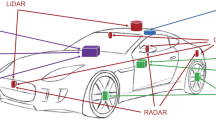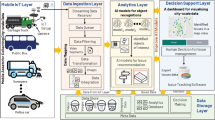Abstract
A border surveillance operation requires sophisticated sensor planning, as sensors are usually scarce and cannot cover an entire region simultaneously. Border patrol agents act as moving sensors in a border region, and the border patrol agents’ coverage moves around the region dynamically, increasing the chance of approaching a trespassing agent. Typically, the locations of trespassing agents cannot be fully observed due to the size of the border region and obstacles. In addition, intelligent trespassing agents may dynamically adjust their traveling paths so that the border patrol agents cannot predict their locations easily. Trespassing agents are assumed to leave traces that indicate their footprints, providing their estimated locations. Border patrol agents may use the trespassers’ footprints as partial information to leverage patrol path planning. We propose an adaptive border patrol process as a partially observable Markov decision process (POMDP), in which an individual border patrol agent’s decision is determined dynamically on the basis of trespassing agents’ partially observed locations. The observations are shared among individual border patrol agents, allowing the border patrol agents to cooperate. The zoning technique is used to limit the planning scope of an individual border patrol agent, and Monte Carlo simulation is applied to reduce the complexity of the POMDP planning problem. Empirical experiments are conducted by means of simulated agents. The simulation parameters are derived from the interviews with a group of border patrol experts. The results in different scenarios show that the proposed patrol path planning scheme outperforms other patrol path planning schemes in terms of the trespasser detection rate. The simulation results are validated with respect to subject matter experts (SMEs), where SMEs are the same border patrol experts who had given the interviews. The proposed method has potential in border surveillance as an assisting system for human border patrol or an automated guidance system in robots or drones.













Similar content being viewed by others
References
Rossmo D K, Thurman Q C, Jamieson J D, Egan K (2008) Geographic patterns and profiling of illegal crossings of the southern US border. Secur J 21(1-2):29–57
Tsianos V, Karakayali S (2010) Transnational migration and the emergence of the European border regime: an ethnographic analysis. Eur J Soc Theory 13(3):373–387
European Parliament and Council of the European Union (2013) Regulation (EU) No 1052/2013 of the European Parliament and of the Council of 22 October 2013 establishing the European Border Surveillance System (Eurosur)
U.S. Customs and Border Protection (2018) Border Surveillance System (BSS). Retrieved 8 December 2019, from https://www.dhs.gov/sites/default/files/publications/privacy-pia-cbp022-bss-september2018.pdfhttps://www.dhs.gov/sites/default/files/publications/privacy-pia-cbp022-bss-september2018.pdfhttps://www.dhs.gov/sites/default/files/publications/privacy-pia-cbp022-bss-september2018.pdf
Jones R, Johnson C (2016) Border militarisation and the re-articulation of sovereignty. Trans Inst Br Geogr 41(2):187–200
Shumov V V (2019) The model of the rationale for the focus of border security efforts at the state level. Comput Res Model 11(1):187–196
Liu B, Dousse O, Nain P, Towsley D (2013) Dynamic coverage of mobile sensor networks. IEEE Trans Parallel Distrib Syst 24(2):301–311
Clouqueur T, Phipatanasuphorn V, Ramanathan P, Saluja K K (2003) Sensor deployment strategy for detection of targets traversing a region. Mob Netw Appl 8(4):453–461
Elmaliach Y, Agmon N, Kaminka G A (2009) Multi-robot area patrol under frequency constraints. Ann Math Artif Intell 57(3-4):293–320
Xing G, Wang J, Yuan Z, Tan R, Sun L, Huang Q, et al. (2010) Mobile scheduling for spatiotemporal detection in wireless sensor networks. IEEE Trans Parallel Distrib Syst 21(12):1851–1866
Agmon N, Urieli D, Stone P (2011) Multiagent patrol generalized to complex environmental conditions. In: Twenty-Fifth AAAI conference on artificial intelligence (AAAI)
Komar C, Donmez M Y, Ersoy C (2012) Detection quality of border surveillance wireless sensor networks in the existence of trespassers’ favorite paths. Comput Commun 35(10):1185–1199
Park C H, Kim Y D, Jeong B (2012) Heuristics for determining a patrol path of an unmanned combat vehicle. Comput Ind Eng 63(1):150–160
Kartal B, Godoy J, Karamouzas I, Guy S J (2015) Stochastic tree search with useful cycles for patrolling problems. In: Proceedings of the 2015 IEEE international conference on robotics and automation (ICRA), pp 1289–1294
Sigurdson D, Bulitko V, Yeoh W, Hernández C, Koenig S (2018) Multi-Agent Pathfinding with Real-Time heuristic search. In: Proceedings of the 2018 IEEE conference on computational intelligence and games (CIG), pp 1–8
Pawgasame W, Wipusitwarakun K (2020) Mobile sensors’ patrol path planning in unobservable border region. International Journal of Intelligent Computing and Cybernetics
Kaelbling L, Littman M, Cassandra A (1998) Planning and acting in partially observable stochastic domains. Artif Intell 101(1-2):99–134
Silver D, Veness J (2010) Monte-carlo planning in large POMDPs. Proc Adv Neural Inf Process Syst 23:2164–2172
Pastore T H, Everett HR, Bonner K (1999) Mobile robots for outdoor security applications. Space And Naval Warfare Systems Center, San Diego Ca
Keung G, Li B, Zhang Q (2012) The intrusion detection in mobile sensor network. IEEE/ACM Trans Netw 20(4):1152–1161
Ȧström K (1965) Optimal control of Markov processes with incomplete state information. J Math Anal Appl 10(1):174–205
Smallwood R D, Sondik E J (1973) The optimal control of partially observable Markov processes over a finite horizon. Oper Res 21(5):1071–1088
Russell S J, Norvig P (2016) Artificial intelligence: a modern approach. Pearson Education Limited, Harlow
Bellman R E (1957) Dynamic programming. Princeton University Press, Princeton
Pineau J, Gordon G, Thrun S (2003) Point-based value iteration: An anytime algorithm for POMDPs. Proc Eighteenth Int Joint Conf Artif Intell 3:1025–1032
Ross S, Pineau J, Paquet S, Chaib-Draa B (2008) Online planning algorithms for POMDPs. J Artif Intell Res 32:663–704
Shani G, Pineau J, Kaplow R (2013) A survey of point-based POMDP solvers. Auton Agent Multi-Agent Syst 27(1):1–51
Spaan M T, Vlassis N (2004) A point-based POMDP algorithm for robot planning. Proceedings of the 2004 IEEE International Conference on Robotics and Automation (ICRA), pp 2399–2404
Paquet S, Chaib-draa B, Ross S (2006) Hybrid POMDP algorithms. In: Proceedings of the workshop on multi-agent sequential decision making in uncertain domains, pp 133–147
Kurniawati H, Hsu D, Lee W S (2008) Sarsop: Efficient point-based pomdp planning by approximating optimally reachable belief spaces. Robotics: Science and systems 2008
Spaan M T, Gonçalves N, Sequeira J (2010) Multirobot coordination by auctioning POMDPs. In: Proceedings of the 2010 IEEE international conference on robotics and automation (ICRA). Anchorage, pp 1446–1451
Bai H, Cai S, Ye N, Hsu D, Lee W S (2015) Intention-aware online POMDP planning for autonomous driving in a crowd. In: Proceedings of the 2015 IEEE international conference on robotics and automation (ICRA). Seattle, pp 454–460
Luo Y, Bai H, Hsu D, Lee W S (2019) Importance sampling for online planning under uncertainty. Int J Robot Res 38(2-3):162–181
Nguyen H V, Chesser M, Koh L P, Rezatofighi S H, Ranasinghe D C (2019) Trackerbots: Autonomous unmanned aerial vehicle for real-time localization and tracking of multiple radio-tagged animals. J Field Robot 36(3):617–635
Kocsis L, Szepesvári C (2006) Bandit based monte-carlo planning. In: Proceedings of the European conference on machine learning, Berlin, pp 282–293
Onur E, Ersoy C, Deliç H, Akarun L (2007) Surveillance wireless sensor networks: Deployment quality analysis. IEEE Netw 21(6):48–53
Author information
Authors and Affiliations
Corresponding author
Ethics declarations
Conflict of interests
The authors declare that they have no conflict of interest.
Additional information
Publisher’s note
Springer Nature remains neutral with regard to jurisdictional claims in published maps and institutional affiliations.
Rights and permissions
About this article
Cite this article
Pawgasame, W., Wipusitwarakun, K. Mobile sensor patrol path planning in partially observable border regions. Appl Intell 51, 5453–5473 (2021). https://doi.org/10.1007/s10489-020-02068-6
Accepted:
Published:
Issue Date:
DOI: https://doi.org/10.1007/s10489-020-02068-6




